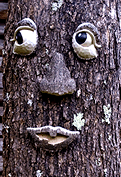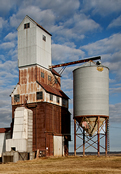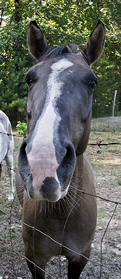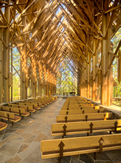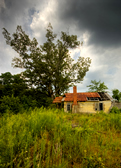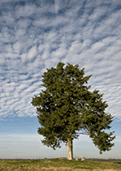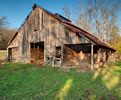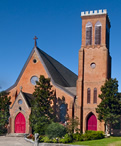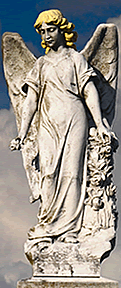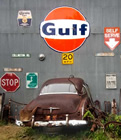|
|
|
|
 |
|
|
|

Well over 100 years old, this old dogtrot house in Cleveland, Arkansas, sits right on Highway 95 for all to see. Since time is taking its toll, get a good look. A few more ill winds and it could become kindling. 
Sunday, October 28, 2012 The first thing you notice as you approach Cleveland from the south on Arkansas Highway 95 is this old dogtrot house. It was built and first occupied in the last quarter of the century-before-last. For the mathematically and historically challenged, that would be after 1875 and before 1900. Like most dogtrot houses that enjoyed long-term occupancy, at sometime in its life the dogtrot breezeway was closed to make a new room, and consequently stop the wintery winds from blasting through the middle of your house.  The left (north) side of the front porch will be the first to go. You can easily see where the dogtrot was closed in the center. The "home-place-tree" in the background is a healthy walnut, which will probably long outlive the house. Cleveland is now a small, small community, more than a few notches less than a mere shadow of its former self. The once bustling town boasted a major mercantile and land enterprise, a lot of businesses, and a lot of people, according to the retired minister who was kind enough to fill me in on his home. Now in his nineties, he should know. He was born and raised there, across the highway from the old dogtrot. He has returned to the place of his birth for retirement.  The back of the house shows evidence of additions made after the original structure was completed. The missing roof segment lies in the foreground of the picture.  A closer look at the deteriorating back porch shows some details of expansions. The different-size clapboards tell the tale. The stone structure is the family well, a real convenience in that location. It saved many a step into the jaws of ill weather. I met the minister after I knocked on his door seeking information on the old home. Since he lives directly across the highway, I surmised that the property might be his and if so, would he object if I photographed it, and further, could I pick his brain on the provenance of the structure? He informed me that he was not the owner, and that since the owner of the structure recently made the big one-way trip to see his Maker, he could see no problem with either of my requests. Though his home in its present manifestation bore not the slightest resemblance to a dogtrot house, the elder clergyman told me that it was built by his grandparents and was virtually a clone of the one I was about to photograph.  As the minister regaled me with historical Cleveland tidbits, he injected a "story." The setting is Cleveland sometime around the turn of the last century. As with many small towns of that genre in that day and time, there was a large mercantile and land company, which dominated the local economy. Let's just say the company was owned by Mr. Smith and Mr. Jones. That said, the story
In their wanderings, they happen across an upturned wash pot. The devil stops the tour at that point and tells his fledgling resident that he can go just about anywhere on the premises he cares to go, but under no circumstances can he approach or touch the overturned wash pot. After a while longer, the new resident can't hold his curiosity in check and asks the devil, "What's the deal with the wash pot?" The devil quickly replies, "Mr. Smith and Mr. Jones are under the wash pot and I'm afraid that if they escape, within a couple of weeks they will have 'all-over-hell' mortgaged." From the top photograph, you can see where the original chimney resided as opposed to the current location further inside the house. The rest of the life cycle of the house follows a typical path. From the differences in the clapboard siding planks, you can see that the home was expanded several times.  A close look at the foundation for the old structure reveals simple engineering at its best. It did make for cold floors in the winter. In that day and time, the first order of business was to get out of the weather. As the family and earning power grew, so did the house. An addition here. An addition there. Then at some point the children reach adulthood and seek their fortunes elsewhere. Sooner or later family income diminishes and the home suffers for maintenance. Which brings us to where we are today.  No, I am not crazy, nor are you seeing things. This is not citrus fruit. These are ripening black walnuts on the huge home-place tree in the backyard of the house. The tree was full of 'em. The old structure has great value because it reminds us of how we got here, how life was before we got here, and how our forbearers made successes out of what they had.
N O T E S:
Most of the time, there is more to the Photo of the Week story than can be told in an essay. And most of the time there are more pictures to be seen. Presuming that some folk will enjoy being privy to this trove of information, I have created a blog, “Weekly Grist for the Eyes and Mind,” where I am showing and telling “the rest of the story." There are also some blatantly commercial mentions of some of the things we do to earn our beans and taters. Click on the Weekly Grist logo and go to the blog. — J. D.
 |
|
|
|
|
|

|
|
|
|
CornDancer.com is the personal website of Dr. Freddie A. Bowles and Ebenezer Baldwin Bowles.
CornDancer has participated in the World Wide Web since 2000. Submissions are invited. Contact webmaster at threadspinner@corndancer.com |
|
|
|
 continues. Seems a local citizen reports that he has had a bad dream in which he winds up in hell. The dreamer reports to the devil, whom he finds to be reasonably cordial as he, Beelzebub hisself, gives the new arrival the two-bit tour.
continues. Seems a local citizen reports that he has had a bad dream in which he winds up in hell. The dreamer reports to the devil, whom he finds to be reasonably cordial as he, Beelzebub hisself, gives the new arrival the two-bit tour.







